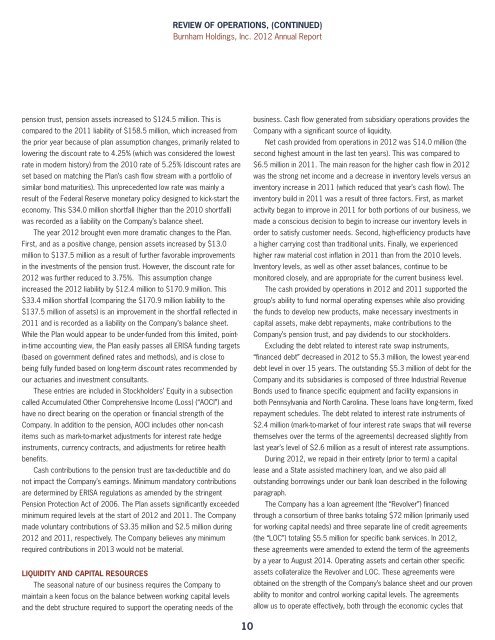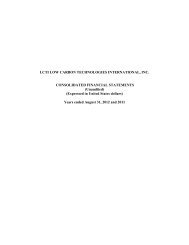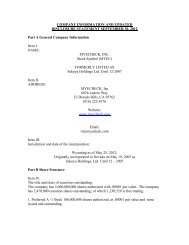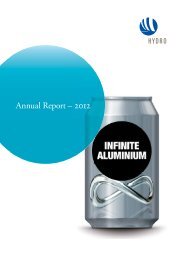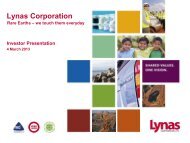Burnham Holdings, Inc.
Burnham Holdings, Inc.
Burnham Holdings, Inc.
Create successful ePaper yourself
Turn your PDF publications into a flip-book with our unique Google optimized e-Paper software.
pension trust, pension assets increased to $124.5 million. This is<br />
compared to the 2011 liability of $158.5 million, which increased from<br />
the prior year because of plan assumption changes, primarily related to<br />
lowering the discount rate to 4.25% (which was considered the lowest<br />
rate in modern history) from the 2010 rate of 5.25% (discount rates are<br />
set based on matching the Plan’s cash flow stream with a portfolio of<br />
similar bond maturities). This unprecedented low rate was mainly a<br />
result of the Federal Reserve monetary policy designed to kick-start the<br />
economy. This $34.0 million shortfall (higher than the 2010 shortfall)<br />
was recorded as a liability on the Company’s balance sheet.<br />
The year 2012 brought even more dramatic changes to the Plan.<br />
First, and as a positive change, pension assets increased by $13.0<br />
million to $137.5 million as a result of further favorable improvements<br />
in the investments of the pension trust. However, the discount rate for<br />
2012 was further reduced to 3.75%. This assumption change<br />
increased the 2012 liability by $12.4 million to $170.9 million. This<br />
$33.4 million shortfall (comparing the $170.9 million liability to the<br />
$137.5 million of assets) is an improvement in the shortfall reflected in<br />
2011 and is recorded as a liability on the Company’s balance sheet.<br />
While the Plan would appear to be under-funded from this limited, pointin-time<br />
accounting view, the Plan easily passes all ERISA funding targets<br />
(based on government defined rates and methods), and is close to<br />
being fully funded based on long-term discount rates recommended by<br />
our actuaries and investment consultants.<br />
These entries are included in Stockholders’ Equity in a subsection<br />
called Accumulated Other Comprehensive <strong>Inc</strong>ome (Loss) (“AOCI”) and<br />
have no direct bearing on the operation or financial strength of the<br />
Company. In addition to the pension, AOCI includes other non-cash<br />
items such as mark-to-market adjustments for interest rate hedge<br />
instruments, currency contracts, and adjustments for retiree health<br />
benefits.<br />
Cash contributions to the pension trust are tax-deductible and do<br />
not impact the Company’s earnings. Minimum mandatory contributions<br />
are determined by ERISA regulations as amended by the stringent<br />
Pension Protection Act of 2006. The Plan assets significantly exceeded<br />
minimum required levels at the start of 2012 and 2011. The Company<br />
made voluntary contributions of $3.35 million and $2.5 million during<br />
2012 and 2011, respectively. The Company believes any minimum<br />
required contributions in 2013 would not be material.<br />
LIQUIDITY AND CAPITAL RESOURCES<br />
The seasonal nature of our business requires the Company to<br />
maintain a keen focus on the balance between working capital levels<br />
and the debt structure required to support the operating needs of the<br />
REVIEW OF OPERATIONS, (CONTINUED)<br />
<strong>Burnham</strong> <strong>Holdings</strong>, <strong>Inc</strong>. 2012 Annual Report<br />
10<br />
business. Cash flow generated from subsidiary operations provides the<br />
Company with a significant source of liquidity.<br />
Net cash provided from operations in 2012 was $14.0 million (the<br />
second highest amount in the last ten years). This was compared to<br />
$6.5 million in 2011. The main reason for the higher cash flow in 2012<br />
was the strong net income and a decrease in inventory levels versus an<br />
inventory increase in 2011 (which reduced that year’s cash flow). The<br />
inventory build in 2011 was a result of three factors. First, as market<br />
activity began to improve in 2011 for both portions of our business, we<br />
made a conscious decision to begin to increase our inventory levels in<br />
order to satisfy customer needs. Second, high-efficiency products have<br />
a higher carrying cost than traditional units. Finally, we experienced<br />
higher raw material cost inflation in 2011 than from the 2010 levels.<br />
Inventory levels, as well as other asset balances, continue to be<br />
monitored closely, and are appropriate for the current business level.<br />
The cash provided by operations in 2012 and 2011 supported the<br />
group’s ability to fund normal operating expenses while also providing<br />
the funds to develop new products, make necessary investments in<br />
capital assets, make debt repayments, make contributions to the<br />
Company’s pension trust, and pay dividends to our stockholders.<br />
Excluding the debt related to interest rate swap instruments,<br />
“financed debt” decreased in 2012 to $5.3 million, the lowest year-end<br />
debt level in over 15 years. The outstanding $5.3 million of debt for the<br />
Company and its subsidiaries is composed of three Industrial Revenue<br />
Bonds used to finance specific equipment and facility expansions in<br />
both Pennsylvania and North Carolina. These loans have long-term, fixed<br />
repayment schedules. The debt related to interest rate instruments of<br />
$2.4 million (mark-to-market of four interest rate swaps that will reverse<br />
themselves over the terms of the agreements) decreased slightly from<br />
last year’s level of $2.6 million as a result of interest rate assumptions.<br />
During 2012, we repaid in their entirety (prior to term) a capital<br />
lease and a State assisted machinery loan, and we also paid all<br />
outstanding borrowings under our bank loan described in the following<br />
paragraph.<br />
The Company has a loan agreement (the “Revolver”) financed<br />
through a consortium of three banks totaling $72 million (primarily used<br />
for working capital needs) and three separate line of credit agreements<br />
(the “LOC”) totaling $5.5 million for specific bank services. In 2012,<br />
these agreements were amended to extend the term of the agreements<br />
by a year to August 2014. Operating assets and certain other specific<br />
assets collateralize the Revolver and LOC. These agreements were<br />
obtained on the strength of the Company’s balance sheet and our proven<br />
ability to monitor and control working capital levels. The agreements<br />
allow us to operate effectively, both through the economic cycles that


